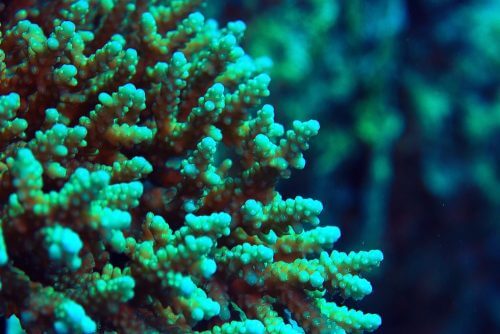A coral is actually a colony of tiny, jellyfish-like animals called polyps. These polyps form a thin layer of tissue that covers the skeleton based on calcium, which itself is built from carbon dioxide and calcium that the polyps absorb from the water. Most of the energy for this process is contributed by unicellular algae

Coral reefs are sometimes referred to as the "rainforests of the ocean", and serve as a base for many of the marine food webs. The stony corals, which build the reef, also absorb about 90-70 tons of carbon from the atmosphere each year, which contributes to the reduction of greenhouse gases and slows climate warming. Because of this, the ongoing extinction of corals, caused in large part as a result of man-made environmental changes, may further affect our lives. But what, exactly, causes the coral to die? This question concerns many scientists in the world, including scientists at the Weizmann Institute of Science. The institute's scientists have developed a new experimental system, which makes it possible to keep living coral in microflow conditions. This system makes it possible to study the living mechanisms of corals at a higher resolution than ever before, thus contributing to the understanding of the processes that contribute to the extinction of these fascinating creatures.
A coral is actually a colony of tiny, jellyfish-like animals called polyps. These polyps form a thin layer of tissue that covers the skeleton based on calcium, which itself is built from carbon dioxide and calcium that the polyps absorb from the water. Most of the energy for this process is contributed by unicellular algae: they grow inside the coral's cells, providing it with oxygen and nutrients. In return, they receive carbon dioxide and nutrients from the corals, and among their "branches" they find shelter from predators. This symbiosis is of great importance when it comes to the ongoing destruction of coral reefs. For, one of the vulnerabilities in corals, which ultimately causes their death, is "bleaching": the corals lose the algae that grow with them, and their white shell is exposed. "To understand what happens when bleaching occurs in corals," he says Dr. Assaf Vardi, from the Department of Plant and Environmental Sciences at the Weizmann Institute of Science, "We must delve into what happens to these creatures, under different conditions, at the cellular and molecular level."

Dr. Verdi and the members of his group - the post-doctoral researcher Dr. Or Shapira, Dr. Esti Winter, and research student Assaf Gabish - in collaboration with Prof. Roman Stoker from the Massachusetts Institute of Technology (MIT) and the Swiss Federal Institute of Technology (ETH ), developed a system which they call "coral on a chip". This system, which allowed scientists, for the first time, to examine living coral polyps under a microscope, is based on microflow technology that allows them to control the environmental conditions with a minimal volume of water, while monitoring cellular processes in the coral. In order to develop the system, the scientists exposed a small piece of coral to stressful conditions, and as a result, the coral released its polyps. The released polyps were "settled" by the scientists in the microflow cells, and thus they could observe, with the help of a microscope, tiny coral colonies growing and developing under controlled conditions.
Using the system they developed, the scientists photographed, for the first time, the development of aragonite crystals - the building blocks that make up the coral skeleton. The research group even managed to predict the starting point of a disease that attacked one of the corals. Exposing the tiny coral colonies to high light intensities, which are known to cause coral bleaching, allowed the members of the group to follow the process of losing the algae, that is, the bleaching - cell by cell.
The research group is already in the midst of adapting the new system to monitor the food and carbon cycles of corals that make up reefs, with the aim of learning more about the mechanisms of disease and bleaching in corals. "Many corals don't have much time left," says Dr. Vardi. "We must understand in depth how humans affect the corals' ability to survive, and how they affect our survival. The system we developed may help scientists investigate a wide variety of topics: the coral's genes involved in its survival, reef-building methods that corals use, and the effect of corals on the marine carbon cycle."

One response
absorb about 90-70 tons of carbon from the atmosphere ???
Maybe twice a thousand or twice a million